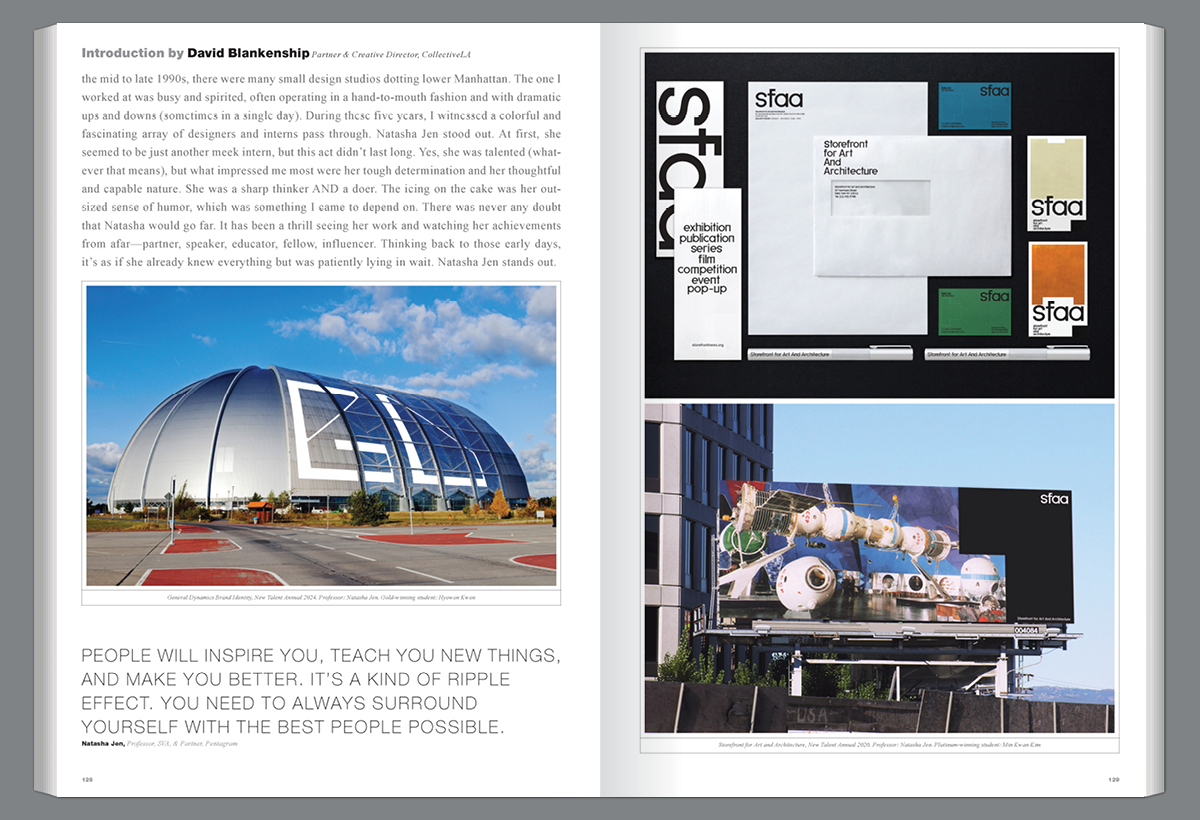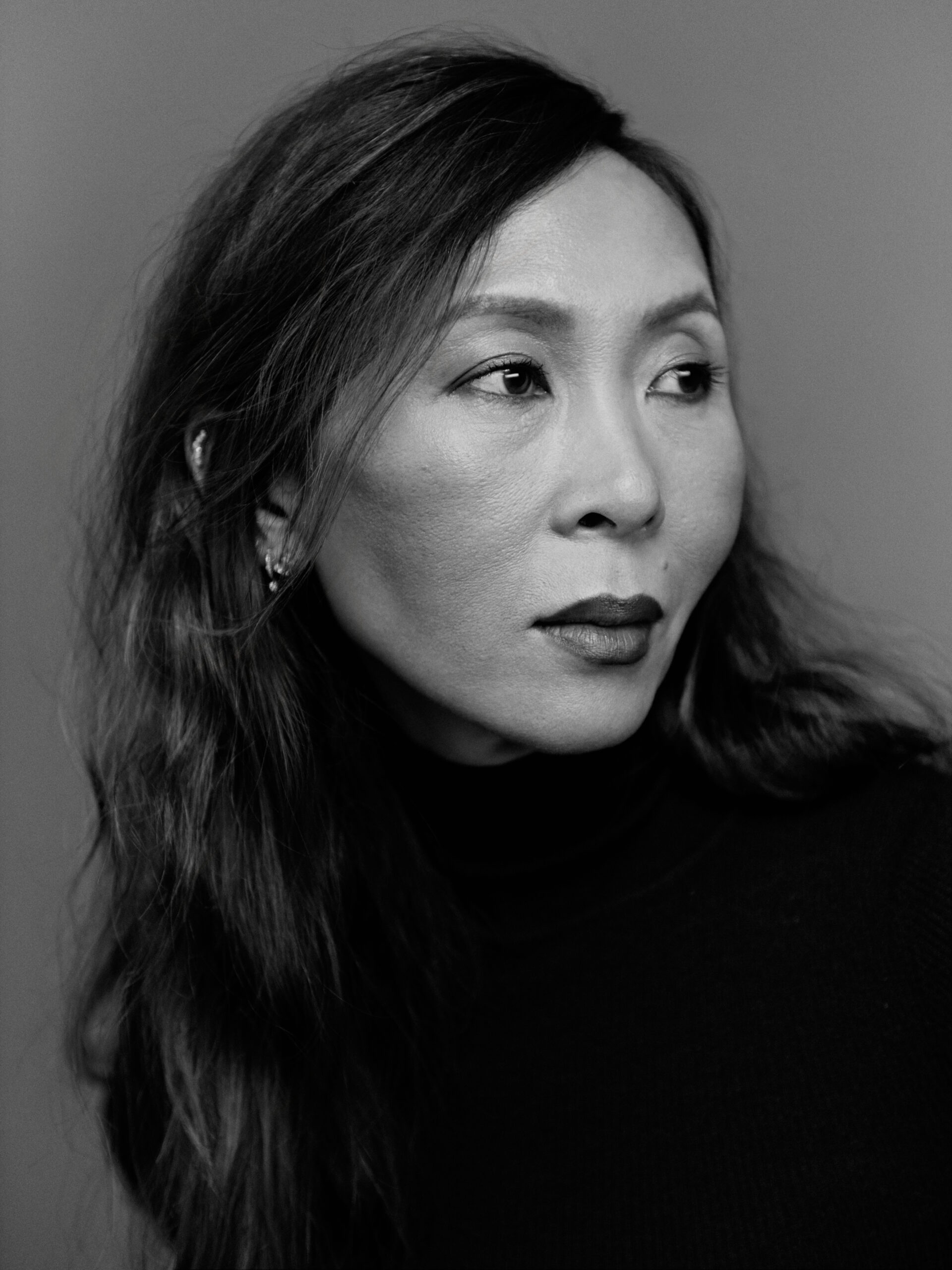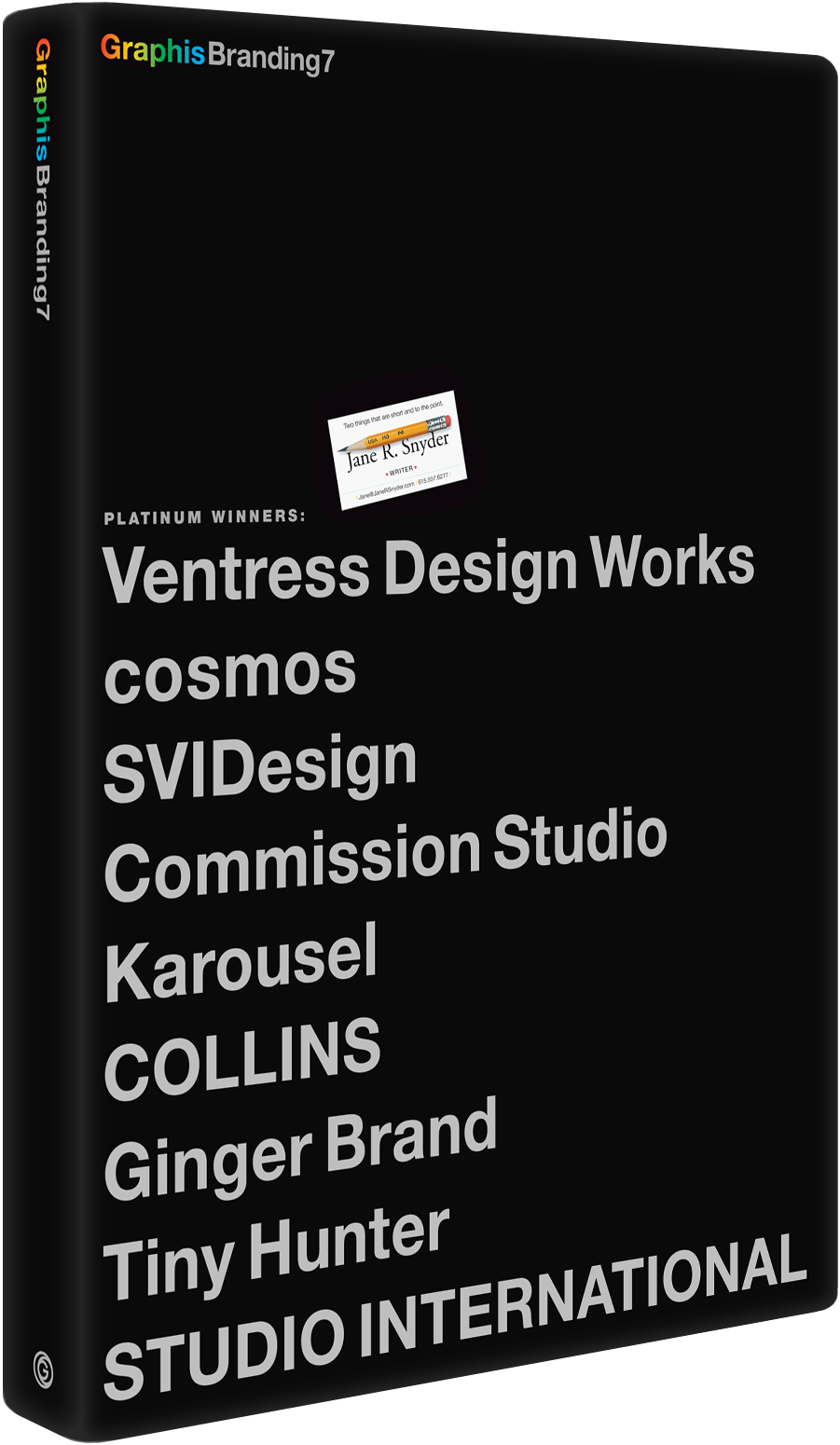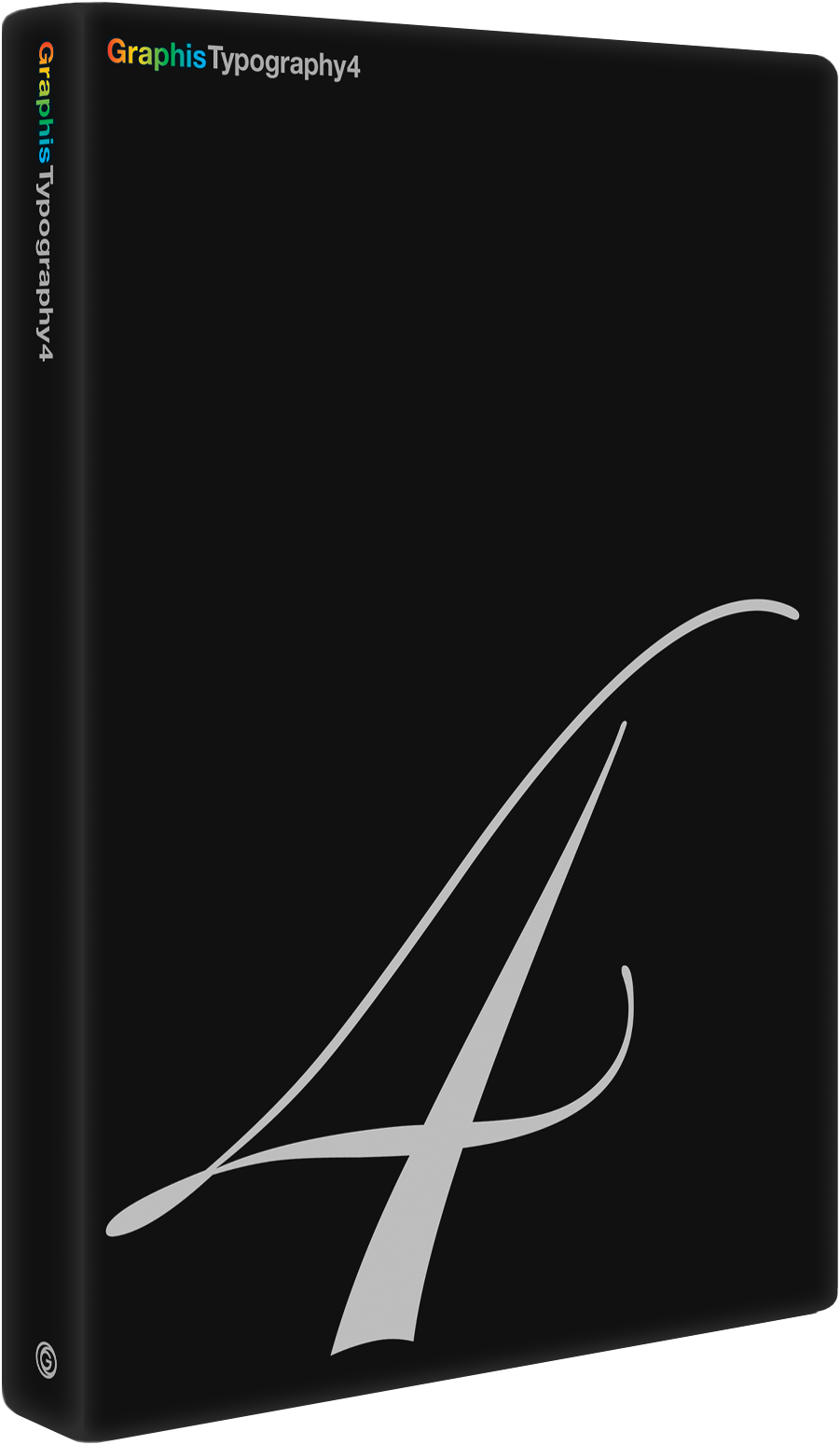Pentagram Powerhouse Natasha Jen
Natasha Jen isn’t just a designer—she’s a force of nature. Hailing from Taipei, Taiwan, and shaking things up at Pentagram’s New York office since 2012, she’s been a six-time National Design Award nominee and an AIGA standout. Natasha’s work doesn’t just push boundaries; it smashes them, blending graphic, verbal, digital, and spatial elements to flip the script on what media and culture can be.
Introduction by David Blankenship, Partner & Creative Director, CollectiveLA
In the mid to late 1990s, there were many small design studios dotting lower Manhattan. The one I worked at was busy and spirited, often operating in a hand-to-mouth fashion and with dramatic ups and downs (sometimes in a single day). During these five years, I witnessed a colorful and fascinating array of designers and interns pass through. Natasha Jen stood out. At first, she seemed to be just another meek intern, but this act didn’t last long. Yes, she was talented (whatever that means), but what impressed me most were her tough determination and her thoughtful and capable nature. She was a sharp thinker AND a doer. The icing on the cake was her outsized sense of humor, which was something I came to depend on. There was never any doubt that Natasha would go far. It has been a thrill seeing her work and watching her achievements from afar—partner, speaker, educator, fellow, influencer. Thinking back to those early days, it’s as if she already knew everything but was patiently lying in wait. Natasha Jen stands out.

What is your process for selecting students for your classes? Are there certain qualifications they have to meet?
Most of the time, we can’t select students, but there’s a reason why these courses are structured according to students’ level of learning. That’s why you would take Typography 101; there’s a reason for structuring courses in a very progressive manner. I teach third-year and fourth-year classes, but my class is structured differently from the other courses.
My class is structured as a two-year course. After two years, it allows me to understand a student better because they take the time to figure out their tendencies as a designer. Everybody has very different creative tendencies, you know, impulses. Sometimes, it’s something they are particularly talented in.
My principle of teaching is helping my students improve in the field they’re interested in or where they already excel. For example, a lot of students tend to lean towards illustration. Graphic design has much more to do with typography, and while its constructive elements may involve illustration, it’s never illustration in itself. When encountering a student who is good at illustration, the point is not to kill that interest. The point is to cultivate that, but they must also be introduced to a broader graphic design vocabulary.
I often get a roster of students who have already signed up for the class, but I want to make sure that they can make this class worthwhile, meaning they need to be at a minimum requirement level to learn effectively.
The very principle of education is structured around progressive learning. If you teach something too deep too early on, students will not be able to absorb it or perform well. I want to ensure my students are prepared.
There are cases with students whose work doesn’t feel like they’re ready yet. That means they will have to go back and study other courses first to be successful.
What might be a typical first assignment in your class?
It depends. For a third-year student, which is the entry point of the course, they would read a book. For example, they could read The Little Prince, a story about a young boy’s journey and his encounters with human beings, all with very different qualities. Once they read the assigned book, the following assignments would be given.
The first assignment would be to visualize the story through a diagram or visualization. Visualizations transform a written story into graphic representations of the narrative and characters. This assignment might take three weeks.
The next assignment would be to create a reimagined book design for the assigned story. This is an editorial and typography exercise. The subject matter stays the same, but students practice deciphering and reinterpreting the story through different assignments.
Do you ever have your students work on assignments for real clients?
Never. I find it unethical. Why should students design for real-world clients who are profiting and benefiting from that? Once you get into these questions, that is a big no-no for me. We design for our clients, and we get paid for that. Students should not be involved in this process. However, we can create imaginary assignments for an existing company or organization that doesn’t serve anybody. That allows students to encounter certain design problems. But that is not for a client. That doesn’t serve anybody.
Do you ever ask your students to include something they’re passionate about in their work for your class?
Well, “Do what you’re passionate about” is never a good assignment because that’s too broad, right? What they’re interested in can actually be a choice of media or medium. If it’s an open medium assignment, that means it can be anything: a song, a book, an exhibit, a toy, whatever. That’s open-ended. That allows them to choose the subject or medium they’re interested in.
An assignment can also be open-ended in a subject matter, but the ultimate output must be one particular medium. For example, students could design a zine on any subject they like. If they like music—jazz, hip hop, etc.—go ahead! It can also be a zine about food. It can be anything, but it must be a zine. And what is a zine? They have to research. It’s more about creating opportunities for students to investigate and answer questions for themselves and not so much doing what they’re passionate about. You don’t need to go to school to do what you’re passionate about. You can do it on your own.
Do you work with students individually, in groups, or a combination of the two?
Our class is structured as a presentation by each student and a group critique. We have a three-hour class with up to 13 or 14 students. Time management is crucial to ensure that every student gets equal time to present and discuss. My role in those critique sessions is to help them measure their own time to structure their presentation better. They must explain what they did, the stories they want to tell, and the work itself. Once they’re actually doing the presentation, they’re already thinking about how they will present it. That way, they can practice presenting to a group in this class.
How do you develop and raise your students’ visual and verbal standards?
That’s very hard to answer because there are no describable words about what constitutes good work. It’s all very assignment- and context-specific. What I require everybody to do is first structure their work through their research. Research should primarily be images because we don’t want an essay on screen while presenting. There should be a rough script in their mind about the research: what they found, what was discovered, what inspired them, and what motivated their concept. Then, they talk about their concept and their design. They have to present ideas and concepts first. All my classes are structured this way, and I want my students to become very familiar with this method of working.
Because design involves creating visual things, it’s also largely analytical. You have to think along your design process. Teaching students this work method is meant to help them develop a habit of continuing a creative and intuitive approach to design.
At the end of the semester, what kind of advice do you like to give the class?
I don’t want to sound cliché, but the first principle is always to work as hard as possible. Be aware of your hard work, and remember that it will pay off. At one point, the power of working hard will have tangible effects: putting in extra hours, revisiting work repeatedly, and really trying to improve it. Deadlines are created by other people, by instructors in a school situation, and, in the real world, by clients and their situations. But remember that there’s never a finish line when it comes to creative work.
My first bit of advice is that you can always improve your work, though you have to work really hard on that. My second piece of advice is to identify people who inspire you and the best people who can be around you. Identify people you can hang out with and learn from within your immediate or adjacent environment. People will inspire you, teach you new things, and make you better. It’s a kind of ripple effect. You always need to surround yourself with the best people possible.
Can you name a few of your past students who have gone on to gain success? And if so, where are they now?
I have many, actually. One example is Leo Porto, who runs his own design studio, Porto Rocha. He’s an example of a student who went through education and worked hard. He was talented, of course, and he surrounded himself with the best practitioners before he started his own business. AJ Kim, who I believe graduated in 2020 during COVID-19, is currently at Google. She worked with me for years and was terrific in many ways: versatile, independent, and a very talented designer. She’s one example of somebody who graduated from school and didn’t have much experience with the real world, but she worked hard and figured things out on her own. There’s also Hansol Jang, who was in AJ’s class. He worked for me for a couple of years and is now at Apple.
What attracted you to teaching at your current school? Were you a student there?
Yeah, I was at SVA. I went to their undergraduate program.
Do you think university-level training is needed in the creative field? How does university-level training help people in the creative field?
That’s a question for any field, right? Like, does it need to exist at all if there are people who intuitively know how to do it? I mean, you see those exceptional ones in almost every field. They don’t need to go to school, but there is immense value in higher education. I still believe that. If there are people who find themselves successful without higher education, that’s fine, too. However, I think the assumption that creative fields don’t require rigorous training is false. Creativity is no different from engineering or physics.
On top of being a teacher, you also work at Pentagram, one of the best design firms in the country. How does your job at Pentagram influence your teaching job?
I do work at Pentagram, but it’s not a job. I’m actually a co-partner and co-owner of the company. This is my practice. That’s very important.
I’m not sure that the specific company defines how I work and how I teach. At Pentagram, we’re in a very privileged position where we have clients with exciting assignments who come to us. That exposure is something that we’re very thankful for. All design assignments and problems have their own challenges, so it’s really up to the designer to make them unique. That has nothing to do with where you work. You must find something attractive, even if the project is seemingly dull or mundane. Once you actually make it interesting, you will likely do much better work.
That applies to the practice as well as teaching, for example, because students are often not interested in certain things. They’re like, “I’m not interested in that subject matter. I don’t know. I don’t like to set type,” right? But the point is when confronting something seemingly boring, you have to figure out how to make it interesting to you.
Natasha Jen is an award-winning designer, educator, and partner at Pentagram. She was born in Taipei, Taiwan, and joined Pentagram’s New York office in 2012. A six-time National Design Award nominee and a member of AIGA, Natasha’s work is recognized for its innovative use of graphic, verbal, digital, and spatial interventions that challenge conventional notions of media and cultural contexts. Her work is immediately recognizable, encompassing brand identity systems, packaging, exhibition design, digital interfaces, signage, wayfinding systems, print, and architecture. Her clients have included a wide range of collaborators from global technology brands to cultural institutions, including Google, Pfizer, Waze, Reddit, Lightmatter, Galaxy Digital, the New York Botanic Garden, the Asian American Foundation, the Harvard Graduate School of Design, and the Metropolitan Museum.

Social: Instagram, Facebook, LinkedIn, X (Twitter)
To discover other talents in issue #382 of The Graphis Journal, click here.
You may also like
Hacin’s Anniversary Set Boxed Up in Style
Boston-based design powerhouse Hacin marked its 30th anniversary in style, earning a Gold in the Graphis Design…
Read MoreFragile Hearts and Hammered Ideals: Mirko Ilić
Mirko Ilić has once again proven his mettle in the design world, clinching Gold in the Poster…
Read More
Related Annuals & Publications
View AllBecome a Graphis Member
- 1-Year Membership Subscription
- Enjoy 50% off on Call for Entries
- 1-Year FREE Subscription to Graphis Journal
- Your Portfolio online with profile + links
- Get 20% off on Graphis Books








